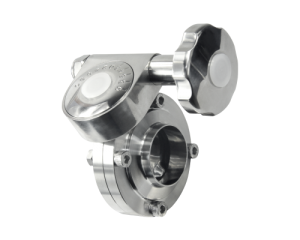Sanitary Valves in Our Daily Life

How Are Valves Used in Everyday Life?
Everyone has heard the word “valve” before. And almost everyone is familiar with using common valves. We all use valves in our daily lives, from our kitchen to other areas like the garden or bathroom. Sanitary valves refer to a type of valve used in places with high sanitary requirements. Most people may not have heard of sanitary valves before, but it’s reasonable to assume that every beverage you’ve ever drunk in your life has passed through a sanitary valve.
Where Are Valves Used?
Sanitary valves are not only used in industrial production fields like pharmaceutical, food, and beverage industries. They’re also in your home. In the kitchen, we use a pressure cooker valve that operates with vapor pressure during cooking. It controls and maintains a particular pressure level that helps food boil and cook to a certain degree of heat. This is called a safety valve. The safety valve is a valve mechanism for the automatic release of a substance from a pressure vessel, boiler, or another system when the pressure or temperature exceeds predefined limits. It retains the steam in the container, which facilitates quick and fast cooking.

Sanitary Valves in Our Daily Life
What Is the Purpose of a Sanitary Valve?
Almost all the valves are more or less the same with their technical know-how. However, they are slightly different in their technical configuration, and they’re known by various names like sampling valves, ball valves, butterfly valves, gate valves, bypass valves, and so on. Millions of valves are available on the market to meet your needs. But still, it is quite essential to have some knowledge about the different types of valves and their uses. Sanitary faucets are found virtually in all phases of industrial development and in the manufacture of consumable goods. Using a proper, high-quality valve can save you many costs such as environmental costs, repairs, and maintenance costs. Indirectly, it can also save employees health risks from harmful chemicals from leaking and damaging pipes.
This type of sanitary shut-off valve is well applied to stainless steel piping systems for the food, beverage, dairy, brewing, pharmaceutical, and chemical industries, where sterility and hygiene are the top priority. There are some series of valves that can be operated manually or automatically. Many process industries use automatic valves to reduce time and labor. Optimizing the use of valves with increasing demands, most manufacturers and traders have emerged with different types of valves with excellent critical characteristics as their main product in the industry. They also offer engineering suggestions to choose the right valve for your home, office, or industry.
What Are the Major Uses of Valves?
The main uses of valves are specific to each individual type of valve. However, there are several basic principle functions that valves are used for:
- Certain valves can connect or cut off the medium in the pipeline, such as gate valves, globe valves, ball valves, plug valves, diaphragm valves, butterfly valves, etc.
- Valves can adjust and control the flow and pressure of the medium in the pipeline, such as the throttle valve, regulating valve, pressure reducing valve, safety valve, etc.
- Valves can change the direction of medium flow in the pipeline, such as the distribution valve, three-way cock, three-way or four-way ball valve, etc.
- Valves can prevent the medium in the pipeline from flowing backward, such as check valves and bottom valves of various structures.
- Valves can separate media, such as steam traps and air traps with different structures.
Conclusion
Thank you for reading this article, and we hope it can help you better understand sanitary valves used in our daily lives. If you want to learn more about valves, we would like to advise you to visit the Adamant Valves homepage for more information.




